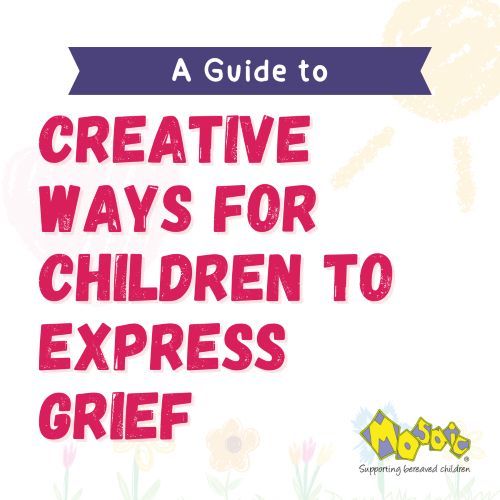Creative Ways for Children to Express Grief

Creative Ways for Children to Express Grief Through Art, Nature or Play
When a child experiences the death of someone close, it can be hard to know how to help. As a parent, carer, teacher or trusted adult, you may worry about saying the wrong thing or feel unsure how to support a child who can’t fully explain how they’re feeling.
At Mosaic, we understand that grief looks different for every child. While some talk openly, others may withdraw or struggle to find the words. That’s why creative approaches – through art, nature and play – can be such valuable tools for emotional expression and healing.
Here are some gentle, practical ideas to help children explore their grief in a way that feels safe and age-appropriate.
Art: A Window into Emotions
Children often express emotions through images before they’re able to verbalise them. Art allows them to safely explore sadness, anger, confusion and love in a way that’s tangible and freeing. There’s no right or wrong in grief-related art. Simply creating can be healing in itself.
How you can support this:
Create a Memory Box Together
Offer a small box for the child to decorate and fill with drawings, photographs, letters or small keepsakes. This private collection can help them feel connected to the person they’ve lost.
Make a Feelings Collage
Using old magazines, paper, stickers or paint, encourage children to create a visual map of their emotions. Collages help externalise feelings and may even open up space for discussion.
Use Drawing to Express Difficult Feelings
Ask open-ended questions like, “Can you draw what your sadness looks like?”
Art With Affirmations
Provide calming background music and ask children to paint or colour around positive words like “love,” “courage,” “memories” or the name of the person they miss. This combines creativity with emotional reassurance.
Nature: Calm, Reassurance and Connection
Time in nature can help children find peace, stability and a sense of belonging. The changing seasons, growth of plants and beauty of the outdoors offer gentle metaphors that children often relate to deeply. Even five minutes of fresh air can have a positive impact on a child’s mood and emotional wellbeing.
Ways to explore nature together:
Memory Walks and Nature Mandalas
Go for walks where children can collect leaves, stones or flowers. Create a “mandala” on the ground in honour of the person they’re missing.
Planting in Memory
Whether it’s a tree in the garden or a pot of forget-me-nots on a windowsill, caring for something that grows can give children a sense of purpose and comfort.
Look to the Sky
Stargazing or cloud-watching can be calming and spark imagination. Children often find it reassuring to imagine a loved one among the stars or nearby in spirit.
Build a Bug Hotel or Bird Feeder
Help children build something small that supports wildlife. This simple act of nurturing something alive can bring peace and encourage reflection on care and connection.
Seasonal Nature Journal
Provide a notebook for children to draw or describe what they notice each week outdoors. Invite them to write a message or memory alongside each entry, linking their experiences in nature with their journey through grief.
Play: A Child’s Natural Language
Through play, children process their world, including grief. It helps them rehearse situations, express fears and find some sense of control in uncertain times.
Encourage safe and supportive play by:
Observing Role Play
Watch how children use toys, dolls or action figures to act out scenarios. They might recreate events surrounding the death or invent stories of saying goodbye or being reunited.
Reading Stories About Loss
Books that explore grief gently can help children feel less alone. Let them ask questions, pause the story or relate the characters to their own experience.
Playing Feelings Games
Use games like charades to act out emotions or match emoji cards to how they feel. This builds emotional vocabulary in a playful, low-pressure way.
Create a Puppet Show
Using simple puppets or handmade sock puppets, children can explore conversations about grief and loss from a safe distance. The “performance” can express thoughts they might otherwise withhold.
Build a Safe Space or Den
Let children create a cosy fort or quiet area with blankets, cushions or tents. A personal retreat can help them regulate their feelings or simply take a break when overwhelmed.
Tip: repetitive or imaginative play often reveals what a child is processing emotionally. Be present and curious, rather than directive.
Your Role as a Supportive Adult
Grief doesn’t always need words. Sometimes, it needs a paintbrush, a tree to water, a make-believe world or simply a listening ear.
Whether you’re a parent, grandparent, carer, teacher or family friend, your presence makes a big difference. Children feel safer expressing themselves when they know the adults around them are calm, accepting and willing to listen, even if they don’t want to talk just yet.
There’s no “right” way to grieve and healing doesn’t follow a timeline. But by offering creative opportunities to express grief, you’re giving children the space to feel seen and supported in a way that works for them.
How Mosaic Can Help
At Mosaic, we specialise in supporting bereaved children and young people across Dorset. Our experienced team uses art, storytelling, play and time in nature as part of our therapeutic approach.
We provide:
- Early Grief Intervention and post bereavement support
- Bereavement Cafes for children and teens
- Activity days, and social events
- Support for schools and professionals
If you know a child who is struggling following the death of a loved one, please don’t hesitate to get in touch.